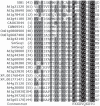The Arabidopsis gene SIGMA FACTOR-BINDING PROTEIN 1 plays a role in the salicylate- and jasmonate-mediated defence responses
- PMID: 20040062
- PMCID: PMC3208021
- DOI: 10.1111/j.1365-3040.2009.02109.x
The Arabidopsis gene SIGMA FACTOR-BINDING PROTEIN 1 plays a role in the salicylate- and jasmonate-mediated defence responses
Abstract
The chloroplast-localized SIB1 protein was previously identified by its interaction with SIGMA FACTOR 1 (SIG1), a component of the RNA polymerase machinery responsible for transcription of plastid genes. The physiological function of SIB1 is little known. We found that expression of SIB1 is induced by infection with Pseudomonas syringae, suggesting its possible involvement in the defence response. The sib1 loss-of-function mutation compromises induction of some defence-related genes triggered by pathogen infection and the treatments with salicylic acid (SA) and jasmonic acid (JA), two key signalling molecules in the defence response. Conversely, constitutive over-expression of SIB1 causes the plants to hyper-activate defence-related genes following pathogen infection or the SA and JA treatments, leading to enhanced resistance to infection by P. syringae. SIB1 is a member of the large plant-specific VQ motif-containing protein family, and might act as a link to connect defence signalling with chloroplast function.
Figures






Similar articles
-
Absence of endo-1,4-β-glucanase KOR1 alters the jasmonate-dependent defence response to Pseudomonas syringae in Arabidopsis.J Plant Physiol. 2014 Oct 15;171(16):1524-32. doi: 10.1016/j.jplph.2014.07.006. Epub 2014 Jul 23. J Plant Physiol. 2014. PMID: 25108263
-
The Arabidopsis thaliana lectin receptor kinase LecRK-I.9 is required for full resistance to Pseudomonas syringae and affects jasmonate signalling.Mol Plant Pathol. 2017 Sep;18(7):937-948. doi: 10.1111/mpp.12457. Epub 2016 Sep 15. Mol Plant Pathol. 2017. PMID: 27399963 Free PMC article.
-
Arabidopsis sigma factor binding proteins are activators of the WRKY33 transcription factor in plant defense.Plant Cell. 2011 Oct;23(10):3824-41. doi: 10.1105/tpc.111.090571. Epub 2011 Oct 11. Plant Cell. 2011. PMID: 21990940 Free PMC article.
-
Priming for enhanced defence responses by specific inhibition of the Arabidopsis response to coronatine.Plant J. 2011 Feb;65(3):469-79. doi: 10.1111/j.1365-313X.2010.04436.x. Epub 2010 Dec 30. Plant J. 2011. PMID: 21265899
-
Salicylate and jasmonate intertwine in ROS-triggered chloroplast-to-nucleus retrograde signaling.Physiol Plant. 2023 Sep-Oct;175(5):e14041. doi: 10.1111/ppl.14041. Physiol Plant. 2023. PMID: 37882286 Review.
Cited by
-
Plastid Gene Transcription: An Update on Promoters and RNA Polymerases.Methods Mol Biol. 2021;2317:49-76. doi: 10.1007/978-1-0716-1472-3_2. Methods Mol Biol. 2021. PMID: 34028762
-
Overexpression of the maize transcription factor ZmVQ52 accelerates leaf senescence in Arabidopsis.PLoS One. 2019 Aug 30;14(8):e0221949. doi: 10.1371/journal.pone.0221949. eCollection 2019. PLoS One. 2019. PMID: 31469881 Free PMC article.
-
Genome-wide comparative analysis of the valine glutamine motif containing genes in four Ipomoea species.BMC Plant Biol. 2023 Apr 22;23(1):209. doi: 10.1186/s12870-023-04235-6. BMC Plant Biol. 2023. PMID: 37085761 Free PMC article.
-
Arabidopsis VQ motif-containing proteins VQ12 and VQ29 negatively modulate basal defense against Botrytis cinerea.Sci Rep. 2015 Sep 23;5:14185. doi: 10.1038/srep14185. Sci Rep. 2015. PMID: 26394921 Free PMC article.
-
Transcriptome dynamic of Arabidopsis roots infected with Phytophthora parasitica identifies VQ29, a gene induced during the penetration and involved in the restriction of infection.PLoS One. 2017 Dec 27;12(12):e0190341. doi: 10.1371/journal.pone.0190341. eCollection 2017. PLoS One. 2017. PMID: 29281727 Free PMC article.
References
-
- Abbink TEM, Peart JR, Mos TNM, Baulcombe DC, Bol JF, Linthorst HJM. Silencing of a gene encoding a protein component of the oxygen-evolving complex of photosystem II enhances virus replication in plants. Virology. 2002;295:307–319. - PubMed
-
- Abramovitch RB, Martin GB. Strategies used by bacterial pathogens to suppress plant defenses. Current Opinion in Plant Biology. 2004;7:356–364. - PubMed
-
- Ausubel FM. Are innate immune signaling pathways in plants and animals conserved? Nature Immunology. 2005;6:973–979. - PubMed
-
- Boch J, Joardar V, Gao L, Robertson TL, Lim M, Kunkel BN. Identification of Pseudomonas syringae pv. tomato genes induced during infection of Arabidopsis thaliana. Molecular Microbiology. 2002;44:73–88. - PubMed
Publication types
MeSH terms
Substances
Grants and funding
LinkOut - more resources
Full Text Sources
Other Literature Sources
Molecular Biology Databases
Research Materials

